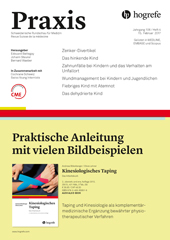Das fiebrige Kind mit Atemnot
Abstract
Zusammenfassung. Die Beurteilung des Kindes mit Fieber und Atemnot erfordert sowohl das Abschätzen des Schweregrades des zugrundeliegenden Infektes wie auch der respiratorischen Symptome, um zeitgerecht adäquate Massnahmen einzuleiten. Hand zur allgemeinen Einschätzung bietet das sogenannte pädiatrische Beurteilungsdreieck und Kenntnis über die Besonderheiten des kindlichen Respirationstraktes. Einziehungen, Nasenflügeln, head bobbing und Hoover-Zeichen sind Zeichen vermehrter Atemarbeit. Die Toleranz für Atemmehrarbeit ist beim Säugling und Kleinkind klein. Daher muss auf Zeichen der respiratorischen Erschöpfung (Atemfrequenzabfall, Atempausen, Veränderung der Vigilanz) unbedingt geachtet werden. Der Entscheid zur Hospitalisierung ist immer von klinischen Faktoren abhängig. Radiologische oder laborchemische Untersuchungen sind für die Primärversorgung nur bedingt ausschlaggebend.
Abstract. The management of a febrile child with respiratory symptoms warrants an accurate assessment of the severity of the underlying infectious disease and the evaluation of the respiratory stability. The «Pediatric Assessment Triangle» und knowledge of the unique specifications of the pediatric respiratory tract are useful tools. The susceptibility to respiratory failure is high in infants, therefore clinicians must be aware of the subtle signs, such as a sudden decrease of the respiratory rate in a previously tachypneic child, mimicking a spontaneously normalized breathing. The decision for referral to the hospital is based on clinical findings. Chest x-ray studies and laboratory results might add further information, but are not crucial for the initial management of the patient.
Résumé. La prise en charge de l’enfant avec fièvre et des symptômes respiratoires demande d’évaluer la gravité de l’infection et des symptômes respiratoires présents. Le « triangle d’évaluation pédiatrique» ainsi que la connaissance des particularités du système respiratoire chez l’enfant nous permettent de faire une évaluation générale. La tolérance pour un effort supplémentaire de respiration est faible chez le nourrisson et le petit enfant. En conséquence des signes d’épuisement respiratoire (hypopnées, apnées, altération de la vigilance) doivent être reconnus. La décision d’hospitalisation doit être prise en fonction de l’état général et des signes cliniques que présente l’enfant et ne peut que rarement dépendre d’un seul diagnostic de laboratoire et/ou de radiologie.
Bibliografie
: The common cold. Lancet 2003; 361: 51–59.
NICE (National Institute for Health and Care Excellence) . Clinical guideline 160: Feverish illness in children. Assessment and initial management in children younger than five years. 2013; https://www.nice.org.uk/guidance/cg160. Letzter Zugriff: 1.11.2016.: The pediatric assessment triangle: a novel approach for the rapid evaluation of children. Ped Emerg Care 2010; 26: 312–315.
: Atemmechanik. In: Rieger C, von der Hardt H, Sennhauser FH, Wahn U, Zach M (Hrsg), Pädiatrische Pneumologie. Springer-Verlag 2013. Kapitel 1.1.3.
: Viral Croup. Am Fam Physician 2004; 69: 535–540.
: Epiglottitis and croup in airway obstruction in children. Anesthesiol Clin N Am 1998; 16: 853–868.
: Croup in the paediatric emergency department. Paediatr Child Health 2007; 12: 473–477.
: Glucocorticoids for croup. Cochrane Database Syst Rev 2011; 1: CD001955.
, .: Konsensus-Statement zur Prävention von Respiratory Syncytial Virus (RSV)-Infektionen mit dem humanisierten monoklonalen Antikörper Palivizumab (Synagis®) Update 2004. Paediatrica 2004; 15: 12–16.
: Clinical Practice Guide line: The Diagnosis, Management and Prevention of Bronchiolitis. Pediatrics 2014; 134: e1474–e1502.
: Salbutamol with metered dose inhalers with spacers – an established emergency treatment for preschool wheeze. Acta Paediatr. 2012; 101: 1161–1163.
, .: Empfehlungen zur Behandlung von obstruktiven Atemwegserkrankungen im Kindesalter (SGPP/PIA-CH 2009). Paediatrica 2009; 20: 44–51.
, .: Impact of the pneumococcal conjugate vaccines on invasive pneumococcal disease in France, 2001–2012. Vaccine 2015; 33: 359–366.
, et al.: British Thoracic Society guide-lines for the management of community acquired pneumonia in children: update 2011. Thorax 2011; 66 Suppl 2: ii1–23.
: Paediatric apnoeas are not related to a specific respiratory virus and parental reports predict hospitalization. Acta Paediatr 2016; 105: 542–548.



